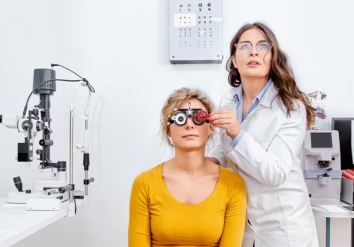
Necessity for Eye check-up among adult particularly after the age of 40 years
Beginning in the early to mid-40s, many adults may start to have problems seeing clearly at close distances, especially when reading and working on the computer. This is among the most common problems adults develop between ages 41 to 60. This normal change in the eyes’ focusing ability, called presbyopia, will continue to progress over time.Initially one may need to hold reading materials farther away to see them clearly or the need to remove glasses to see better up close. Print in the newspaper or small prints may appear blurred especially under dim lighting.
Adults over 40 who have the following health or work issues may be particularly at risk for developing eye and vision problems:
- Chronic, systemic conditions such as diabetes or high blood pressure.
- A family history of glaucoma or macular degeneration.
- A highly visually demanding job or work in an eye-hazardous occupation.
- Health conditions related to high cholesterol, thyroid, anxiety or depression, and arthritis for which you take medications. Many medications, even antihistamines, have vision side effects.
Understanding age-related vision changes:-
Just like your body, your eyes and vision change over time. While not everyone will experience the same symptoms, the following are common age-related vision changes:
Need for more light. As you age, you need more light to see as well as you used to. Brighter lights in your work area or next to your reading chair will help make reading and other close-up tasks easier.
Difficulty reading and doing close work. Printed materials can become less clear, in part because the lens in your eye becomes less flexible over time. This makes it harder for your eyes to focus on near objects than when you were younger.
Problems with a glare. When driving, you may notice additional glare from headlights at night or sun reflecting off windshields or pavement during the day. Changes in your lenses in your eyes cause light entering the eye to be scattered rather than focused precisely on the retina. This creates more glare.
Changes in color perception. The normally clear lens located inside your eye may start to discolour. This makes it harder to see and distinguish between certain colour shades.
Reduced tear production. With age, the tear glands in your eyes will produce fewer tears. This is particularly true for women experiencing hormone changes. As a result, your eyes may feel dry and irritated. Having an adequate amount of tears is essential for keeping your eyes healthy and for maintaining clear sight.
Encountering problems with near vision after 40 years
If you have never needed eyeglasses or contact lenses to correct distance vision, then experiencing near vision problems after age 40 can be concerning and frustrating. You may feel like you’ve abruptly lost the ability to read the newspaper or see the cell phone numbers.These changes in your focusing power have been occurring gradually since childhood. Now your eyes don’t have enough focusing power to see clearly for reading and other close vision tasks.
Losing this focusing ability for near vision, called presbyopia, occurs because the lens inside the eye becomes less flexible. This flexibility allows the eye to change focus from objects that are far away to objects that are close. People with presbyopia have several options to regain clear near vision. They include:
- Eyeglasses, including reading glasses, bifocals, and progressive lenses.
- Contact lenses, including monovision and multifocal lenses.
- Laser surgery and other refractive surgery procedures.
As you continue to age, presbyopia becomes more advanced. You may notice that you need to change your eyeglass or contact lens prescriptions more frequently than you used to. Around age 60, these changes in near vision should stop, and prescription changes should occur less frequently.Presbyopia can’t be prevented or cured but most people should be able to regain clear, comfortable near vision for all of their lifestyle needs.







